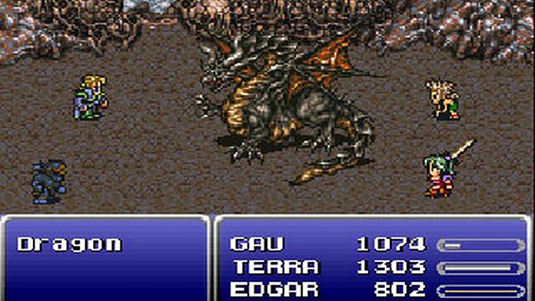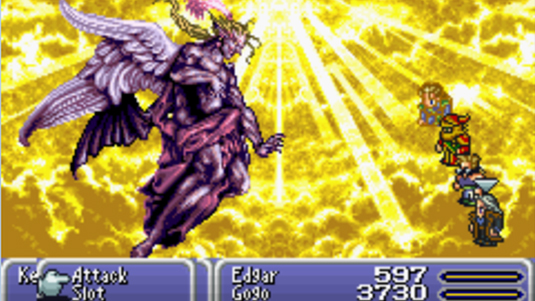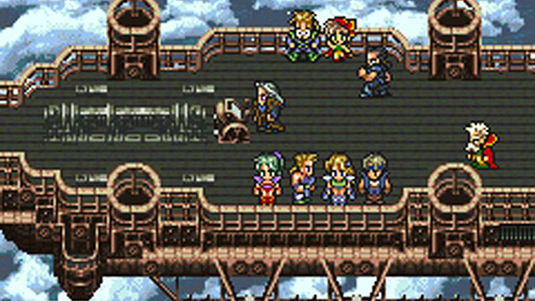I’m coming at you a few days late due to some last-minute ‘plans’ and some editing issues, but Monday night I beat Final Fantasy VI! Yes, this update sees me reaching the end of what seems to be a heavy fan favorite as well as licking the last of the sprite-based adventures. It’s goodbye inch-high, hello models, but I don’t plan on going without a bit of a bang. Here’s how it all went down!
Progress
~Friday, May 24th (After 6PM)
- Realized there was something fishy going on Thamasa
- Spoke to Strago and his granddaughter Relm, but had no luck finding the Espers
- Slept in the inn and was woken by Strago, who revealed that the townspeople could use magic and that Relm was trapped in a burning building
- Braved the inferno and saved Relm
- Went with Strago to the Esper’s Cave and found the statues of the Warring Triad
- Fought off Ultros, and accepted Relm into the party
- Found the Espers and brought them back to Thamasa
- Kefka arrived and knocked out the party, then killed General Leo and obtained the power of many Espers
- Buried Leo in Thamasa and met with the rest of the party, who arrived in the newly-repaired Airship
- Witnessed the raising of the floating continent
- Stopped in Narshe and recruited Mog
~Saturday, May 25th
- Flew to the floating continent and fought off Ultros and Typhon
- Found the injured Shadow and took him with us
- Braved the floating continent and defeated the Ultima Weapon
- Witnessed Kefka’s betrayal of Emperor Gestahl
- Waited for Shadow to arrive, and escaped the floating continent
- Woke up a year after the end of the world as Celes
- Was unable to save Cid’s life, and jumped off of the north cliff in despair
- Survived the fall and discovered Cid’s raft
- Landed near Albrook, then made for Tzen and reunited with Sabin to save a small child
- Made for Nikeah in the North, and found Edgar posing at the leader of the Crimson Robbers
- Snuck aboard the Crimson Robber’s ship and arrived in South Figaro
- Followed ‘Gerad’ from South Figaro to Figaro Castle via the connecting cave
- Helped Edgar free the castle’s engine from the mass of tentacles, and took the castle to Kohlingen
- Reunited with Setzer and set out for Darill’s Tomb
~Sunday, May 26th
- Defeated the Dullahan and retrieved Falcon, the fastest airship in the world
- Gathered together all of the original party members, and a few new ones! (Gogo and Umaro)
- Leveled like there was no tomorrow
~Monday, May 27th
- Leveled like there was no yesterday
- Put together a final party of Celes, Setzer, Terra, and Locke
- Landed atop Kefka’s Tower and began the fight to save a shattered world
- Destroyed Kefka, God of Magic, and escaped from the crumbling tower
- Watched the world begin to rebuild
…And that’s how it ends! I started Final Fantasy VII Tuesday evening, but for now there’s just one last thing to do. Get ready for a bit of a read, because this is a long one!
Parting Thoughts
Final Fantasy VI is one I missed. I had originally started with VII, and seen bits and pieces of the games before it. Even when I got old enough to have games of my own, VI was one I didn’t get to very quickly. Eventually I got my hands on the Anthology collection containing V and VI, and I played V to absolute death. Max level for for the party, every class mastered, and all of the Legendary Weapons. By the time I was done, my hands were ready to fall off. I popped in VI next, excited for the possibilities of this new game, and hadn’t even finished the opening section with Terra before a friend had decided to tell me the plot of the entire second half of the game. While nowadays I don’t mind spoilers so much, when this first happened I just sort of shut down. I dropped the controller and moved on to something else, because I couldn’t bring myself to keep playing. Every time I have gone to try and play VI I’ve run into this wall of apathy and distaste before getting out of Narshe that I just couldn’t seem to shake. Oh sure, I watched other people play it and I read up on it as much as I could, but there’s a level of remembrance you get from playing a game for yourself. A level of experience it’s not possible to get as an onlooker. Now that I’ve forced myself to power through that unpleasant barrier I’ve gotten that experience, and I must say I am so very, very glad I did.
Now, let’s tackle this game section by section. We’ll start with…
COMBAT
The battle system of Final Fantasy VI is essentially the same as the two games before it. Where FFV added the visible ATB gauge (which the original FFIV lacked), FFVI brought in something called a ‘Desperation Attack’. When in critical HP, you had roughly a 1/15 or 16 chance of using a powerful, unblockable attack that ignores defense when choosing the ‘Attack’ command. (To be honest, I never pulled off one of these attacks. I was in critical HP plenty of times near the beginning and toward the very end, but I suppose I was just very unlucky.) While a small addition to the system, it paved the way for the Limit Breaks (or whatever they might be called in a given title) prevalent in the rest of the series and did a good job of adding balance to especially difficult encounters.
 While playing FFVI, I didn’t feel that battles were as slow as they felt in the first five games. As with the last game I mentioned as seeming a little faster, there doesn’t seem to be any evidence that the battle system has actually been sped up. It’s more likely this reduced feeling of waiting around comes from the way actions are staggered and the decent variance in attack animations. While the game still doesn’t achieve the level of speed and efficiency I’ve come to appreciate so much, it’s the most enjoyable of the first six games in this respect.
While playing FFVI, I didn’t feel that battles were as slow as they felt in the first five games. As with the last game I mentioned as seeming a little faster, there doesn’t seem to be any evidence that the battle system has actually been sped up. It’s more likely this reduced feeling of waiting around comes from the way actions are staggered and the decent variance in attack animations. While the game still doesn’t achieve the level of speed and efficiency I’ve come to appreciate so much, it’s the most enjoyable of the first six games in this respect.
ABILITIES AND PARTY
Final Fantasy VI shone pretty brightly in this respect. While the characters in the game returned to FFIV’s style of set personal/unique classes, a certain level of the customization of FFV’s AP-based Job System was retained here. By equipping a piece of Magicite to a character, you could teach them a large range of spells even if their classes wasn’t technically a caster type (with the added bonus of extra stats per level when equipped) and keep them once the Magicite was taken off. These spells were split up a little differently than in other games (white for healing only, black for damage, grey for status effects), but as far as I could tell they had no limits as long as you had the Magicite for it. Passive abilities on the other hand could be gained by equipping Relics (essentially accessories) to your character (up to two), although they could not be learned like spells (removing the Relic removed the effect). Finally, Summons were given a slightly different treatment. As long as you had the Magicite of an Esper equipped, you could summon them once per battle.
 Meanwhile, the party system was definitely a bit of a ride. To my knowledge, this game has the second-highest number of playable characters of a single title in the series, sitting at 14, with two of those being ‘secret’ (Only FFIV: The After Years has more, sitting at around 20 if I remember correctly, with the original FFIV having 12). This large number allowed for the creation of dungeons that required the party to split into groups, something I wish had been utilized in many of the more recent Final Fantasies. Even FFVI itself didn’t use the feature quite enough for my tastes, as beyond one or two storyline dungeons and a section where you get to choose which order to play three groups in the main story this is restricted to optional dungeons such as the Dragon’s Den. Despite this, it was a great tool for storytelling and also allowed for some small variety when traveling through story-important towns if you had a specific character present. This helped break up the feeling of linearity I get when playing older Final Fantasies, and was certainly a treat. I also found it very interesting that as soon as you’ve had Celes meet up with Edgar, Sabin, and Setzer in the World of Ruin you can immediately take on Kefka (although obviously ill-advised). Having the rest of the party re-recruitable by optional sections also alleviated the sore lack of proper sidequests present in early games, which were almost exclusively about extra Summons or post-game dungeons.
Meanwhile, the party system was definitely a bit of a ride. To my knowledge, this game has the second-highest number of playable characters of a single title in the series, sitting at 14, with two of those being ‘secret’ (Only FFIV: The After Years has more, sitting at around 20 if I remember correctly, with the original FFIV having 12). This large number allowed for the creation of dungeons that required the party to split into groups, something I wish had been utilized in many of the more recent Final Fantasies. Even FFVI itself didn’t use the feature quite enough for my tastes, as beyond one or two storyline dungeons and a section where you get to choose which order to play three groups in the main story this is restricted to optional dungeons such as the Dragon’s Den. Despite this, it was a great tool for storytelling and also allowed for some small variety when traveling through story-important towns if you had a specific character present. This helped break up the feeling of linearity I get when playing older Final Fantasies, and was certainly a treat. I also found it very interesting that as soon as you’ve had Celes meet up with Edgar, Sabin, and Setzer in the World of Ruin you can immediately take on Kefka (although obviously ill-advised). Having the rest of the party re-recruitable by optional sections also alleviated the sore lack of proper sidequests present in early games, which were almost exclusively about extra Summons or post-game dungeons.
All of these things, combined together, added a depth to the game that felt brand new to the series. It felt fresh and different, and this is the kind of build and change I have come to expect from Final Fantasy games.
STORY
The story of this game is pretty well written, especially when compared to the entries before it. The script fits the cultural time period, most of the characters have decent backstories, and for the most part things are explained pretty well. I found myself caring a lot about what happened to Celes and Edgar, and I was very curious about both Setzer and Shadow. Particularly I think Shadow being Relm’s father was a pretty great plot point, in part due to the fact that I didn’t figure it out beforehand which is rare, as I usually see these kinds of things coming from a mile away. I was also a little happy it didn’t actually come up in the main story; When Shadow decides to stay behind in Kefka’s Tower at the end, I felt so much more sad that Relm didn’t even realize she was leaving her own father behind.
 On the subject of Celes particularly, I felt bad for her throughout much of the main narrative. Locke seems to see something of his dead fiance in her (more on that in a moment), she looks enough like the Opera singer Maria that Setzer wants to whisk her away and get married (not to mention her resemblance to Darill), and due to my own misunderstanding of a minigame she lost the only father figure she had to illness. The atrocities she was forced to commit in Maranda seem to have almost broken her before we ever even met, and Kefka’s attempt to brand her a double-agent renders her very near speechless toward Locke for the bulk of the game following that. I must admit that by the end I was rooting for Locke and Celes as a couple, and I (embarrassingly) had completely forgotten that Locke had a dead girlfriend out there that he was desperately trying to revive. I ended up playing as a team of Celes, Locke, Setzer, and Terra for most of the World of Ruin as a result of storyline events in these places. I hadn’t even really liked Terra up until she started caring for the children of Mobliz, as I felt she was cold, alienating, and a little bit creepy.
On the subject of Celes particularly, I felt bad for her throughout much of the main narrative. Locke seems to see something of his dead fiance in her (more on that in a moment), she looks enough like the Opera singer Maria that Setzer wants to whisk her away and get married (not to mention her resemblance to Darill), and due to my own misunderstanding of a minigame she lost the only father figure she had to illness. The atrocities she was forced to commit in Maranda seem to have almost broken her before we ever even met, and Kefka’s attempt to brand her a double-agent renders her very near speechless toward Locke for the bulk of the game following that. I must admit that by the end I was rooting for Locke and Celes as a couple, and I (embarrassingly) had completely forgotten that Locke had a dead girlfriend out there that he was desperately trying to revive. I ended up playing as a team of Celes, Locke, Setzer, and Terra for most of the World of Ruin as a result of storyline events in these places. I hadn’t even really liked Terra up until she started caring for the children of Mobliz, as I felt she was cold, alienating, and a little bit creepy.
That’s not to say there weren’t bits and pieces that bothered me, though. Due to the nature of sidestories depending on who you have in your party (beyond whoever is required for the main story), I ended up missing a lot of things including the one line where it was mentioned explicitly that Kefka was the first Magitek Knight and that this drove him crazy. Some parts were written in poor taste, such as Edgar hitting on the 10-year-old Relm. One thing that stood out to me in particular was a major plotpoint of the story that wasn’t explained at all, which may seem small to some but has left me burning to know what happened. It falls in with the story of Kefka, so I will explain it as I talk about him (and then I’ll hurry up and get to the end, I promise).
Kefka Palazzo is one of the best villains I’ve ever seen in Final Fantasy. I even prefer him to Sephiroth, being quite honest, and have a certain amount of respect for how his story went. Being the first of only two Final Fantasy villains to actually succeed in their main quest (the second being Caius of XIII-2), he’s a rather standout character. Even more uniquely, he begins the game as an absolute weakling compared to you. He’s a little bit crazy (okay super crazy), but beyond his political power as Emperor Gestahl’s right-hand man there’s nothing particularly special or intimidating about him. You beat the ever living crap out of him at first, and he even runs away from you at least once in an actual chase scene where he is legitimately trying to escape and not just taunting you. As you continue to encounter him he’s clearly growing stronger, but even when he starts casting spells up to Blizzara he’s never really on even footing with you. After his ‘capture’ by the Empire, though, he hits a sudden (and unexplained) power spike.
 This crazy, psychotic clown-mage walks right into Thamasa and auto-kills no less than three Espers with nothing more than a flick of his wrist. The same Espers, I might add, that had previously decimated the Imperial capital of Vector. In control or not, they had massive amounts of power that he seemed to bypass. Not only that, but when a group of similarly enraged Espers appeared to try and save the others Kefka taunted them with the Magicite he obtained from destroying their friends. He then proceeded to completely negate the powers of all of the Espers with an ability of unknown origin, disintegrating three nearby soldiers and their Magitek Armor in the process. He’s seen using a spell similar in animation to both Banish and Meteor in a battle with an Ifrit-like Esper, which again auto-kills the being and turns it into Magicite for him to use.
This crazy, psychotic clown-mage walks right into Thamasa and auto-kills no less than three Espers with nothing more than a flick of his wrist. The same Espers, I might add, that had previously decimated the Imperial capital of Vector. In control or not, they had massive amounts of power that he seemed to bypass. Not only that, but when a group of similarly enraged Espers appeared to try and save the others Kefka taunted them with the Magicite he obtained from destroying their friends. He then proceeded to completely negate the powers of all of the Espers with an ability of unknown origin, disintegrating three nearby soldiers and their Magitek Armor in the process. He’s seen using a spell similar in animation to both Banish and Meteor in a battle with an Ifrit-like Esper, which again auto-kills the being and turns it into Magicite for him to use.
Perhaps it’s not important to anyone else, but I’d sure as frell like to know what happened between his being locked up in the Vector jails (where he clearly didn’t have this power) and his arrival in Thamasa. Even a flashback or a line would’ve sufficed, but as it stands I can’t help wondering if it might not have made a good story. The narrative can still be solid without it, but I feel like my enjoyment of the moment was a little lessened as a result. In the meantime, though, Kefka took the ridiculous powers he’d just displayed and then added to his growing strength with a museum’s worth of Magicite, and from there he was just sort of a runaway train of pure power and insanity. His final attempt to destroy the world (a year later after he horribly scarred it and dominated its people) seemed out of an overreaction to emotions he didn’t understand anymore, rather than an actual desire to destroy. I mean, he clearly liked to destroy things, it’s just that a few of the lines (wondering where hopes and dreams came from, for example) seemed to paint a deeper picture behind the admittedly satisfying madness.
LAST WORD
Between its solid continuation of the ATB system, interesting choices in the gaining of abilities and party members, and dynamite story I’d have to say that Final Fantasy VI isn’t just a good entry to the series, it’s a fantastic one. Having finally sat down and experienced it myself, I can confidently say that it has replaced FFIII and FFV as my favorites of the original six games and urge anyone who has watched or read the game (but not played it themselves) to give it a try. When you’re actually controlling the characters and moving through the world, the emotional bond is tighter and everything seems to stick around longer. Overall, an awesome game I’ll be glad to pick up again in the future.

Recent Comments